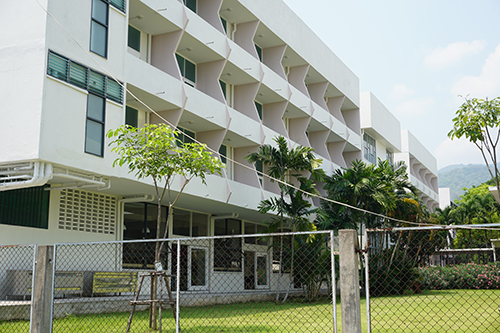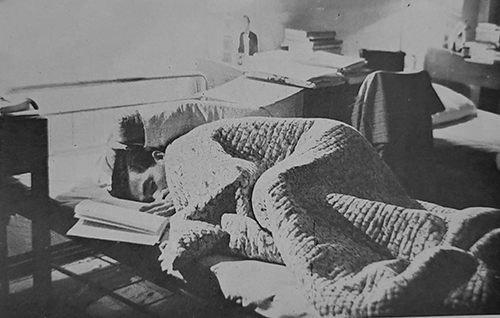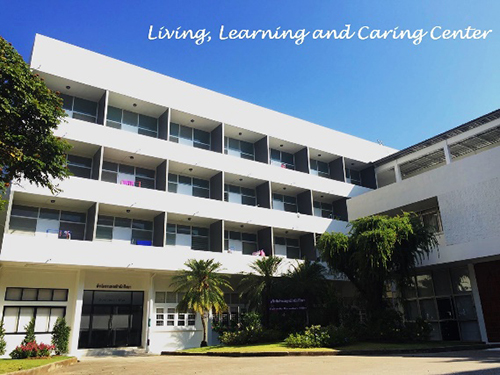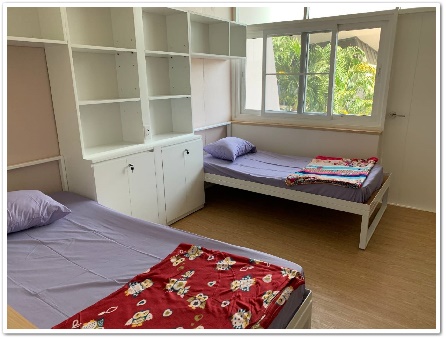Female Dormitory 5
The building layout of the dubbed “female dormitory 5” resembles that of an English H with two sides divided and parallel to one another. The two sides of the building are connected to each other by the single-story common area. The common area has high ceilings made with transparent glass converging together to resemble a graduation cap when viewed from a wide angle. It is said that this symbolism serves to remind the students to persevere through hard times and that success will be waiting for them at the end.
Female Dormitory 5 or “Huen Phuangkram” is one of the dormitories in Chiang Mai University. It was built in 1968. Within the dormitories, there are rules to follow and inconveniences to accommodate, which is why many students found living in a dormitory to be uncomfortable as well as an invasion to their personal space. For example, the students all share one common bathroom. Furthermore, they must learn to compromise and accommodate living together with a roommate whom they have never met before. Most of them are from different provinces with different backgrounds. To add, the students must adhere to the dormitory’s curfew and disciplines. Though these notable points drew up negative views of living in a dormitory, on the other hand, these restrictions also can leave positive impacts and have, in fact, helped many CMU students to graduate. Those graduates will recount the fantastic tales of their dormitory life that only them, and their fellow CMU dorm students will ever know and experience.

The fence that students climb over during the “Over the Fences” experience
Over the Fences: The mentioned experience often happens to students who fail to return to their dorm in time. They, therefore, resort to climbing the back fences to enter their dormitory. Nowadays, climbing the fences and dormitories rarely happens because there are 24-hour CCTV cameras. Not to mention, students who are late to curfew can ring the doorbell to get in. Although, their names will be recorded for disciplinary actions.
Dorm Crashing: Some dormitory students would let their friends “crash” and secretly live in their room in dormitories. In the past, their non-dormitory friends may crash at their place for months, some are not even in the same university! Currently, this is no longer a possible feat because students will need a fingerprint scan to enter the dormitory.
Dormitory Demise: This period of demise happens to some unfortunate students who is unable to draw a raffle to stay in their dorm for another year.
Open-Dorm Day: Once a year, for a day, both the female and male dormitories will be open to all students to visit. There are contests to vote for the “best dorm room” as well as refreshments for the students on the open house day. Unfortunately, the tradition has now been cancelled because male students drank alcohol and created a ruckus within the dormitory.
Giveaways One may wonder, what happens when there is a power outage within the dormitories? At CMU, there is a strange tradition where the male students would ride motorcycles to "Give away things" or shout crude words at the students in the female dormitory to supposedly relieve the stress from exam preps. While this action can be punishable by suspension, there is no doubt that the act itself brings a lot of color to their fellow dorm counterparts. The university made sure to regularly conduct maintenance on the electrical system to minimize the power outage. Consequently, the giveaway now occurs only occasionally.
The dormitory tales appeared at the same time as the dormitory opened. It has a foundation as old as the age of the university. Professor M.L. Pin Malakul, the former minister of education, took student’s accommodation very seriously because Chiang Mai University was the first university in the northern region. The professor laid out a well thought out dormitory plan from the beginning. The goal was to accommodate students from other regions so they could have a place to stay until graduation which in turn, reassured the parents of the students.
Photo CMU in 1970, far left, is the two male dormitories, the next two are the Female Dormitory 3 and the Female Dormitory 2 Photo by Boonserm Satrabhaya
Professor M.L. Pin Malakul has adopted the Residential University Model from Oxford University and Cambridge University in England to propose the “two courses curriculum” consisting of the faculty courses and the college course. The faculty courses aim to provide academic knowledge (needed for the student’s career path. For example, biochemistry for the chemistry major students in the Faculty of Science.) Simultaneously, the college course encouraged students to care for one another and developing life skills outside of the lecture hall. (For example, hosting night studying sessions for upcoming exams.) Both courses provide CMU students with knowledge, awareness, and character. Consequently, this model requires the students to be affiliated with a particular college and to reside in that college for at least two years to better learn life skills outside the classroom.
Historically, during the founding era of Chiang Mai University, the student dormitories are called “college”. The first college are for male students and second college for female students, with faculty members closely supervising students in both colleges. Later, as the number of students increased, the construction of the building also increased giving rise to the naming system such as “college 2, building 5”, which translates to the current female dormitory 5 building.
College 1

College 2


However, as the number of students grew, faculty members were unable to take care of the students as thoroughly as before. As a result, the college system was abolished in 1978, becoming a male dormitory and a female student dormitory to the present. Despite the transition from the college system to the dormitory system, generosity towards students remains. The CMU student dormitory is currently managed by the University Dormitory Office, Chiang Mai University. The core value of the dormitories is centered around creating a “Living, Learning, and Caring Center”. The CMU dormitory is distinct, being a residential space, educational facility and a student development facility. The dormitory has a student care system focusing on caring and generosity towards its residents. It consists of a dormitory supervisor, the dormitory advisor, and the dormitory committee. The dormitory supervisor oversees the dormitory management. The Dormitory advisor manages student and academic activities, organize activities to promote both academic and life subjects, such as organizing academic tutoring and foreign language learning as well as character building, allowing students to engage in activities together such as dormitory merit and volunteer works, to name a few. Lastly, the dormitory committee is made up of senior student dormitory members. They are responsible for monitoring the happiness of their fellow dorm-mates in the general aspects of living.

The University Dormitory Office (above) manages all of the student dormitories.

Additionally, more than 90 percent of the dorm's residents are first-year students. Like all freshmen, most of their worries are either school or love related issues. However, if any dorm students show signs of abnormal behaviors such as not taking showers or cluttering the dorm room, all the staff will work in coordination with the University Dormitory Office to provide psychological counseling. Dormitory psychologists regularly counsel and assess students' mental health. Or, if any student has financial issues, there is an emergency fund the student could borrow.
In addition to the care system, another highlight of the CMU dormitory is that the rooms are booked very quickly in a matter of minutes from the time the server opened. (Some even go to the internet caf? to use its high speed Wi-Fi to increase their chances of getting into a dormitory.) That is because CMU dormitory has the most affordable room rate among the student dormitories in Thailand. Presently, there are 20 student dormitories in the university, divided into 7 male dormitories, 12 female dormitories, and the Mae Hia dormitory located at Mae Hia Agricultural Demonstration and Training Center. The price of each dormitory varies, but the most affordable rooms are in the welfare dormitory with 2,400 baht per semester (including water and electricity bills). The welfare dormitory houses 3 students per room. The common baths in all dormitories have warm shower heating systems powered by solar panels. The rooms are also protected from PM 2.5 dust as well.


The room in the Female Dormitory 5
Study Room
Karaoke rooms are also available.

View of the mountain from the Female Dormitory 8

The Female Dormitory 4

The Female Dormitory 2
Lastly, this generosity-oriented care system makes CMU dormitory a nationally recognized model for the Living, Learning and Caring Center. A dorm is more than just a place to sleep, it is also a place to nurture character and create the identity of the CMU graduates. It is also a place to practice life skills, collaboration skills, and social skills that comes from living together with other students of different backgrounds, economic status, and society. For some students, memories within the dormitory are one of the best memories of their university life, along with life-long friendship they have gained.
For this reason, the graduation cap symbol at the Female Dormitory 5 is equally meaningful as any academic degree. This is a life degree from the dormitory, where students discover and manifest for themselves the value of life learning throughout their time within the Chiang Mai University campus.